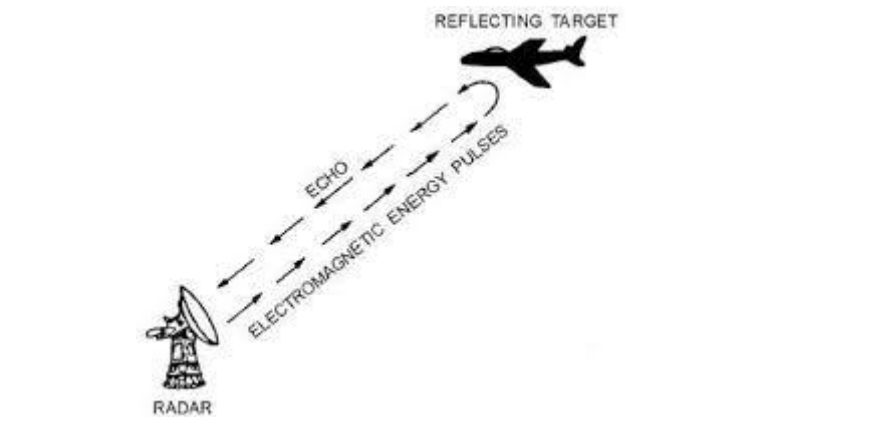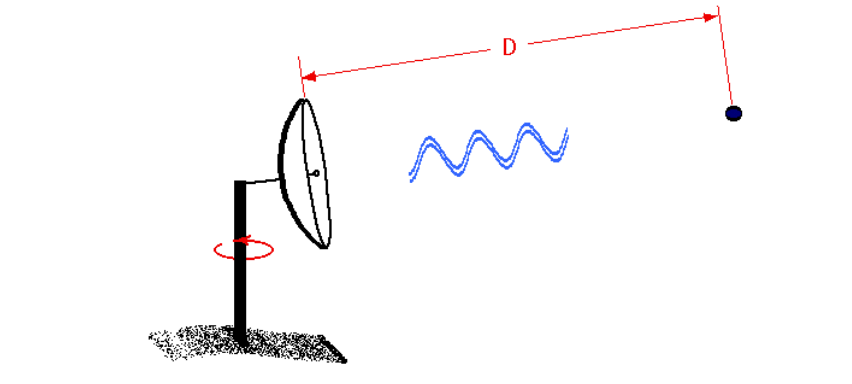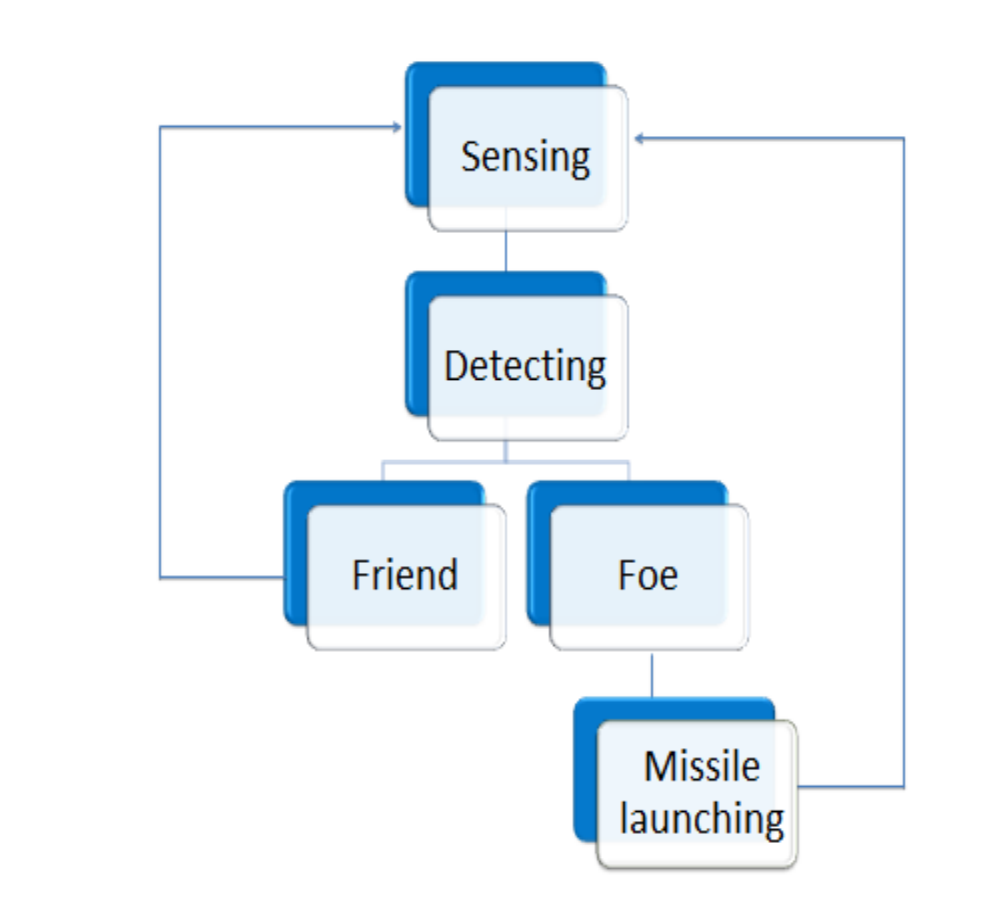Target Locating and Missile Launching Infrared Radar
Target Locating and Missile Launching Infrared Radar. Target Locating and Missile Launching Infrared Radar is an object detection system which uses Infrared Waves to determine the range, altitude, direction, or speed of objects. It can be used to detect aircraft, ships, spacecraft, guided missiles, motor vehicles, weather formations, and terrain.
The radar dish or antenna transmits pulses of radio waves or microwaves which bounce off any object in their path. The object returns an echo (a tiny part of the wave’s energy) to a dish or antenna which is usually located at the same site as the transmitter. The project is used to determine the best hardware and software configuration to maximize the probability of right target detection while minimizing power requirements for the components. The objective was to build an accurate range detection device based on Infrared similar to “radar” detection.
The project displays results in real time. The simulation is validated through testing. This project allows the radar to target the moving object as well. Furthermore, the radar is able to perform quite well in either mode (stationary & moving). Project finds many applications for military as well as civilian purposes.
Radar is an object-detection system that uses radio waves to determine the range, altitude, direction, or speed of objects The term RADAR was coined in 1940 by the United States Navy as an acronym for Radio Detection and Ranging.. The radar dish or antenna transmits pulses of radio waves or microwaves that bounce off any object in their path.
The object returns a tiny part of the wave’s energy to a dish or antenna that is usually located at the same site as the transmitter. Other systems similar to radar make use of other parts of the electromagnetic spectrum. One example is “Lidar”, which uses visible light from lasers rather than radio waves.
What is the Principle of Radar?
The basic principle behind radar is simple – extremely short bursts of radio energy (traveling at the speed of light) are transmitted, reflected off a target and then returned as an echo. Radar makes use of a phenomenon we have all observed, that of the ECHO PRINCIPLE. To illustrate this principle, if a ship’s whistle were sounded in the middle of the ocean, the sound waves would dissipate their energy as they traveled outward and at some point would disappear entirely.
If, however the whistle sounded near an object such as a cliff some of the radiated sound waves would be reflected back to the ship as an echo. The form of electromagnetic signal radiated by the radar depends upon the type of information needed about the target. Radar system has a transmitter that emits radio waves called radar signals in predetermined directions. When these come into contact with an object they are usually reflected or scattered in many directions.
Radar signals are reflected especially well by materials of considerable electrical conductivity—especially by most metals, by seawater and by wet ground. Some of these make the use of radar altimeters possible. The radar signals that are reflected back towards the transmitter are the desirable ones that make radar work. If the object is moving either toward or away from the transmitter, there is a slight equivalent change in the frequency of the radio waves, caused by the Doppler Effect.

Radar receivers are usually, but not always, in the same location as the transmitter. Although the reflected radar signals captured by the receiving antenna are usually very weak, they can be strengthened by electronic amplifiers. More sophisticated methods of signal processing are also used in order to recover useful radar signals.
Literature review of Radar
Radar, the device which is used for detection and ranging of contacts, independent of time and weather conditions, was one of the most important scientific discoveries and technological development that emerged from WWII. Its development, like that of most great inventions was mothered by necessity. The basic idea of radar can be traced back to the classical experiments on electromagnetic radiation conducted by the scientific community in the 19th century.
In the early 1800s, an English physicist, Michael Faraday, demonstrated that electric current produces a magnetic field and that the energy in this field returns to the circuit when the current is stopped. In 1864 the Scottish physicist, James Maxwell, had formulated the general equations of the electromagnetic field, determining that both light and radio waves are actually electromagnetic waves governed by the same fundamental laws but having different frequencies. He proved mathematically that any electrical disturbance could produce an effect at a considerable distance from the point of origin and that this electromagnetic energy travels outward from the source in the form of waves moving at the speed of
light.
At the time of Maxwell’s conclusions there was no available means to propagate or detect electromagnetic waves. It was not until 1886 that Maxwell’s theories were tested. The German physicist, Heinrich Hertz, set out to validate Maxwell’s general equations. Hertz was able to show that electromagnetic waves travelled in straight lines and that they can be reflected from a metal object just as light waves are reflected by a
mirror.
In 1904 the German engineer, Christian Hulsmeyer obtained a patent for a device capable of detecting ships. This device was demonstrated to the German navy, but failed to arouse interest probably due in part to its very limited range. In 1922, Guglielmo Marconi drew attention to the work of Hertz and repeated Hertz’s experiments The first observation of the radar effect was made in 1922 by Dr. Albert Taylor of the Naval Research Laboratory (NRL) in Washington, D.C. Dr.
Taylor observed that a ship passing between a radio transmitter and receiver reflected some of the waves back to the transmitter. In 1930 further tests at the NRL observed that a plane flying through a beam from a transmitting antenna caused a fluctuation in the signal. At the beginning of WWII, Germany had progressed further in radar development and employed radar units on the ground and in the air for defense against allied aircraft. The ability of radar to serve as an early warning device proved valuable as a defensive tool for the British and
the Germans.
Although radar was employed at the start of the war as a defensive weapon, as the war progressed, it came to be used for offensive purposes too. By the middle of 1941 radar had been employed to track aircraft automatically in azimuth and elevation and later to track targets automatically in range. All of the proven radar systems developed prior to the war was in the VHF band. These low frequency radar signals are subject to several limitations, but despite the drawbacks, VHF represented the frontier of radar technology.
Late in 1939, British physicists created the cavity magnetron oscillator which operated at higher frequencies. Although radar technology has been advanced primarily by the military, the benefits have spilled over into many important civilian applications, of which a principal example is the safety of marine navigation. The same fundamental principles discovered nearly a century ago and the basic data they provide, namely target range and bearing, still apply to today’s modern marine radar units.
Target locating and missile launching Infrared Radar
Infrared (IR) is invisible radiant energy, electromagnetic radiation with longer wavelengths than those of visible light, extending from the nominal red edge of visible spectrum at 700 nanometers (frequency 430 THz) to 1 mm (300 GHz). Infrared radiation is used in industrial, scientific, and medical applications. Night-vision devices using active near-infrared illumination allow people or animals to be observed without the observer being detected. Infrared astronomy uses sensor equipped telescopes to penetrate dusty regions of space, such as molecular clouds; detect objects such as planets, and to view highly red-shifted objects from the early days of the universe.
Infrared thermal-imaging cameras are used to detect heat loss in insulated systems, to observe changing blood flow in the skin, and to detect overheating of electrical apparatus. Thermal-infrared imaging is used extensively for military and civilian purposes. Military applications include target acquisition, surveillance and Night vision, homing and tracking. Infrared Radar makes use of Infrared region of the electromagnetic spectrum to detect the target.
Radar detects the signal and signal processing is done by the electronics to determine the range, altitude, direction, or speed of objects. Once time and bearing are measured, these targets or echoes are calculated and displayed on the radar display. The radar display provides the operator a bird’s eye view of where other targets are relative to own ship. Radar is an active device. It utilizes its own radio energy to detect and track the target. It does not depend on energy radiated by the target itself. The ability to detect a target at great distances and to locate its position with high accuracy is two of the chief attributes of radar.
Range measurement
Distance is determined by measuring the time it takes for the pulse to make a round trip from the radar to the target and back using the relation distance = (time) * (velocity). The velocity is the speed of light, the speed at which the pulse travels (c). Since the pulse has to travel to the target and back, the total distance is 2D. If t is the time it takes, then 2D = CT or D = ct/2. Using the calculated distance, azimuth angle and elevation angle, the exact location of the target can be determined.

Measurement of speed and direction of object
Radar (Radio Detection and Ranging) transmits high-frequency, short-wavelength radio waves at the moving object and receives waves reflected from the object. If the object is not moving, the waves bounce back at the same frequency they were transmitted at, and you can determine the distance by how long they take to return. If the object is moving towards the detector, the frequency is higher because each cycle travels a slightly smaller distance, hence returns faster (the Doppler Effect).
If the object is moving away, the frequency is slower for the same reason. The difference is, at low speeds, proportional to the speed of the object. So, if the object moves towards you at 100 wavelengths of the radar wave per second, the received frequency will be 100Hz (or cycles per second) faster than the transmitted frequency. Since you are generating the radar wave at a known frequency, you know the wavelength also.
Block diagram
The Radar first senses the arena, if any object is found; the radar takes the decision whether the object is a friend or foe. If it’s a friend Radar continue it scanning without making any harm to the object but if it’s a foe, Radar activates its missile launching system and continue its scanning.

Also read here for other projects